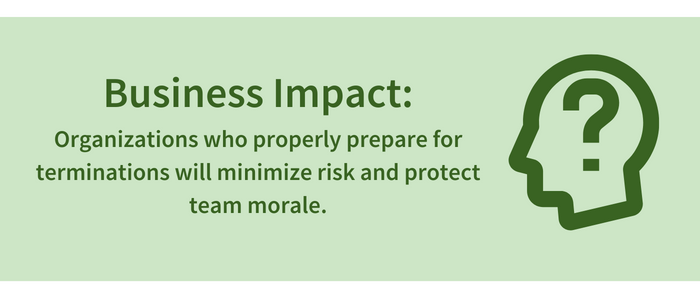Things You Can’t Forget to Do When Terminating an Employee

Terminating an employee, although unpleasant, is sometimes a necessary step as part of the employment relationship. There are many factors that need to be considered and some essential steps that employers can’t forget when terminating an employee. Although most states operate under employment at will, meaning that either the employee or the employer may terminate the employment relationship at any time and for any reason, there are limits to the at-will principle.
Some essential things you need to remember are:
- If the employment relationship is established and protected by contract, such as an employment contract or a collective bargaining agreement in a unionized workplace. In this case, this agreement may limit the parties’ right to terminate employment.
- Many State and federal laws may override and limit the right of an employer to terminate employment. For example, when termination is based on a protected class, status, or activity.
- Specific practices may need to be followed regarding how termination can happen. For example, some states have specific pay out requirements.
Once the decision has been made to terminate an employee, the following steps are important to consider to make sure the termination process runs smoothly:
- Use a checklist to help you stay on track and have control of the conversation.
- This ensures that you address everything needed, it should include the reason why you are discharging the employee and all the documents you need to complete the termination. Prepare this beforehand with all the talking points to cover and gather all the supporting documentation.
- Always include another manager, supervisor, or an HR team member as a witness and to take notes of the conversation.
- Not doing this puts you and your company at risk of numerous “He said, she said” scenarios, none of which are good.
- Decide where the termination meeting is going to take place
- Have an exit plan. Does this person have personal belongings? How will that be handled? Do they have company equipment such as a cell phone, laptop or keys that you need to get?
- It’s usually best to hold the termination meeting at the end of a workday when coworkers are leaving.
- This gives the employee a chance to collect their belongings. Collect their employee ID, entry badge and any other company items. You can either give them the option to come back and collect their items after hours or mail the items to them. Handling this privately helps preserve the dignity of the employee and avoids a negative office environment.
- Always have someone available to escort the former employee while they’re on company property after the meeting.
- Provide information they might need regarding who to contact if there are questions about vacation payouts, benefits, and COBRA information
- Contact IT or security to cancel access or change passwords if applicable.
The goal should be to allow both parties to move on in a positive way. Handling the termination process effectively will help minimize the risks to the organization and protect team morale. It can sometimes feel daunting but taking the time to consider all the factors and prepare a plan will go a long way to making the termination run smoothly.
Written by
Bethania Nunez-Rodriguez

